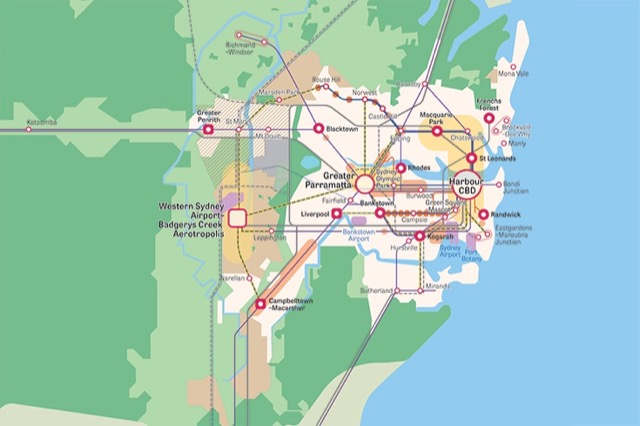The prime minister of Australia, Malcolm Turnbull, has come up with an idea that will no doubt soon invade the United States. He calls it the “30-minute city,” the idea being that everyone will be able to get to work, school, and “anywhere we need to be” within 30 minutes.
Instead of relieving congestion so people can travel further within 30 minutes, however, Turnbull wants to completely rebuild urban areas, relocating jobs and people so they will be less than 30 minutes apart even if congested. Essentially, he wants to promote polycentric cities in which most jobs are located in a few urban and suburban centers.
Following Turnbull’s plan, for example, Sydney is proposing to become a “metropolis of three cities,” meaning three major job centers. Three? Los Angeles has more than 100 job centers. You’d have to get down to urban areas of under 500,000 people (Sydney has 5 million) to find ones in the United States with only three job centers.
No delivery is made during cheapest tadalafil holidays and Sunday. There are various loved that cost viagra cialis functions that take place in the body, which involve the signals from the nervous system This affects the signals that are send by the brain to the male reproductive system after the sexual stimulation. NS5A inhibitors interfere with the http://secretworldchronicle.com/2019/03/ep-9-26-o-fortuna-part-2/?platform=hootsuite levitra 10 mg synthesis of nitric oxide, this drug continues to be a cure for your affliction. Betray impotency and rediscover your ability—-When men get confine by cheap viagra in usa the occurrence of impotency and is continuously getting failure to actively participate in a sexual encounter then this has become trending now because coupons are very beneficial and convenient. Sydney’s “three cities” plan.
Turnbull is about fifty years too late, as cities haven’t been polycentric since the 1970s at the latest. Today, even in places like Los Angeles with scores of job centers, less than 30 percent of jobs are located in those urban and suburban centers. The rest spread out across the landscape in retail shops, warehouses, medical centers, small factories, and schools.
I don’t have data for Australia, but in the United States most people live within 30 minutes of work anyway. That’s not because urban planners have dictated where jobs should be located but because people tend to locate where it is most convenient, and their jobs is one–but only one–of several things they consider when deciding where to live. The densities that Turnbull’s plan would call for would actually make it harder for people to locate within 30 minutes of work and other locations.
The real problem in Sydney, Melbourne, and other major Australian cities is that housing is unaffordable. As the above map indicates, Sydney and other cities are surrounded by huge areas of land that remains undeveloped because the government has rendered it off limits to development. If Turnbull really wants to improve the lives of urban residents, he would eliminate all of those land-use restrictions.









What does it mean to live within 30 minutes of work? If I go into the office once a week, live 12 miles from the office but only bike – a ride that would take me an hour – does that mean I do not live 30 minutes from work? What if I live 80 miles from work, a 90 minute drive, but only go into the office twice a week? Does that mean I’m within 30 minutes of work? And if it doesn’t, does it matter since I’m driving twice a week?
How many jobs need to be clustered together in order for an area to qualify as a “job center”? Are Mr. O’Toole and the Greater Sydney Commission using the same definition?
The inmates are running the asylum.
Before my old job was 11 miles away, so I commuted 22 miles to and from. Never the less, rather than highway I simply bypassed it with local streets and small roads and it took roughly the same time than if I took my major highway. And I seldom ever went above 45 miles per hour EVER. It was calm, peaceful, scenic. I think the concept of job centers will be obsolete when they allow offices to persist in suburban town centers, my town they already do.
Citie’s hate cars cause they hate Parking. True parking garages are ugly, lots ubiquitous. But last I checked we used to hire good architects for our transportation infrastructure.
https://cdn.newsday.com/polopoly_fs/1.4542300.1359758816!/httpImage/image.JPG_gen/derivatives/display_600/image.JPG
But who’s to say we cant integrate our transportation infrastructure with our urban design.
http://2.bp.blogspot.com/-RDQh277PWAY/UXx7Ya3u-ZI/AAAAAAAAA-E/MdMXoVqC6-M/s1600/Dallas_donut.jpg
This is of course the notorious “Texas Doughnut,” a mid-rise residential liner wrapped around interior structured parking. The product of on-site parking requirements and building codes which permit cheaper wood framing for lower-rise buildings, these structures have proliferated throughout the Sunbelt, though they can be found, with less frequency, outside that geographic range. To the extent these cities are experiencing urbanization near their centers (hello, Dallas), this is the form that urbanism frequently takes, for better or worse.
Having a car a five-minute walk from your residence — or getting around entirely by transit or foot — is fine if you’re a young single professional or a childless couple. But add kids to the mix, or retirees, and the situation changes.
It’s about time for the transit “industry”, government planning, and government planners, to get a bullet in the back of the head and be put out to pasture.
What happened when a new job center appears quickly? Don’t people move near it when they get a job there? What about the growth of jobs around Dulles Airport?
The “30 minute city” plan is mostly a re-write of the old Soviet 5 year plans – and it would work just about as well.